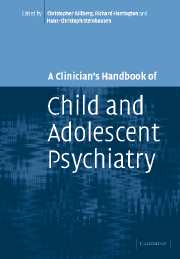Book contents
- Frontmatter
- Contents
- Preface
- List of contributors
- 1 Brain disorders
- 2 Substance use disorders
- 3 Schizophrenia and schizophrenia-like disorders
- 4 Affective disorders
- 5 Anxiety disorders
- 6 Obsessive-compulsive disorders
- 7 Adjustment disorders
- 8 Post-traumatic stress disorder
- 9 Functional somatic symptoms and somatoform disorders in children
- 10 Eating disorders: anorexia nervosa and bulimia nervosa
- 11 Sleep disorders
- 12 Personality disorders
- 13 Mental retardation/learning disability
- 14 Specific developmental disorders of speech and language
- 15 Reading and other learning disorders
- 16 Autism spectrum disorders
- 17 Hyperkinetic disorders
- 18 Conduct disorders
- 19 Elective mutism
- 20 Attachment and disorders of attachment
- 21 Tic disorders
- 22 Elimination disorders: enuresis and encopresis
- 23 Physical and sexual abuse
- 24 Gender identity disorders
- Index
- References
10 - Eating disorders: anorexia nervosa and bulimia nervosa
Published online by Cambridge University Press: 06 August 2009
- Frontmatter
- Contents
- Preface
- List of contributors
- 1 Brain disorders
- 2 Substance use disorders
- 3 Schizophrenia and schizophrenia-like disorders
- 4 Affective disorders
- 5 Anxiety disorders
- 6 Obsessive-compulsive disorders
- 7 Adjustment disorders
- 8 Post-traumatic stress disorder
- 9 Functional somatic symptoms and somatoform disorders in children
- 10 Eating disorders: anorexia nervosa and bulimia nervosa
- 11 Sleep disorders
- 12 Personality disorders
- 13 Mental retardation/learning disability
- 14 Specific developmental disorders of speech and language
- 15 Reading and other learning disorders
- 16 Autism spectrum disorders
- 17 Hyperkinetic disorders
- 18 Conduct disorders
- 19 Elective mutism
- 20 Attachment and disorders of attachment
- 21 Tic disorders
- 22 Elimination disorders: enuresis and encopresis
- 23 Physical and sexual abuse
- 24 Gender identity disorders
- Index
- References
Summary
Introduction
Most typically, the two eating disorders anorexia nervosa (AN) and bulimia nervosa (BN) have their onset in adolescence and young adulthood. The two disorders in their typical manifestation are thus related to a period of major developmental change. The onset of anorexia nervosa, however, can be seen even before puberty and in rare cases, also at the age of 60 or older. For bulimia nervosa (BN) the typical age at onset is the period of transition from adolescence to young adulthood. It is present in a large proportion of patients in their 20s but also in their 30s and 40s. In a substantial number of cases, anorexia nervosa precedes bulimia nervosa and, in adolescence, the combination of AN with bulimic features is clinically more common than pure BN.
Thus child and adolescent psychiatrists have to deal with a large proportion of anorectic and a smaller proportion of bulimic patients, including a subgroup in which the features of the two disorders combine. Furthermore, the child and adolescent psychiatrist is confronted with a large group of subclinical cases of eating disorders. These cases are marked by a more or less pronounced pattern of dietary attempts with some of them qualifying for the diagnosis of an atypical eating disorder or eating disorder not otherwise specified (EDNOS).
A third category of eating disorders, namely binge eating disorder, is appearing more and more on the map of clinical nosology.
- Type
- Chapter
- Information
- A Clinician's Handbook of Child and Adolescent Psychiatry , pp. 272 - 303Publisher: Cambridge University PressPrint publication year: 2006
References
- 1
- Cited by



